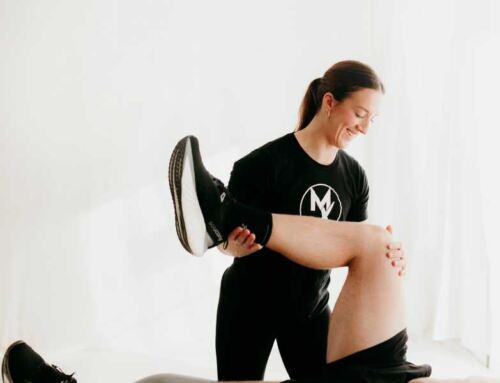Unlocking Your Stride: The Advantages of Integrating Running Analysis with Physical Therapy
As a physical therapist, I often see runners presenting with overuse injuries stemming from strength, stability, and running mechanics issues. While a standard evaluation can identify deficits in strength and stability, it may miss subtle compensations in movement patterns seen with running. Leveraging the emergence of artificial intelligence and compact running analysis systems, enables easier implementation of running analysis, even in mobile settings without a treadmill or complex systems. Integrating running analysis into a physical therapy exam, can enhance treatment plans, reducing pain, improving running technique, and lowering injury risks.
Specifically, the Runeasi system comprises a neoprene belt with an integrated sensor worn during a brief 5-10 minute run. The sensor records data every 5 seconds, focusing on three specific areas: Dynamic Stability, Symmetry, and Impact Loading. These areas play crucial roles in influencing running performance and injury prevention.

Dynamic Stability
When running, maximizing energy efficiency is key to propelling ourselves forward with sprinting or long distance runs. Dynamic stability, or the degree of lateral movement or “wobble” during running, is crucial to control. Enhancing dynamic stability can reduce overuse injuries in the low back and hips.
An effective exercise to improve this is Hip clocks:
- Imagine standing in the middle of a clock.
- Slowly reach one foot out towards 2 o’clock then back to the start position.
- Repeat for 3, 4, and 7 o’clock, respectively.
- Work on keeping your hips level as you reach out with control.
- Repeated 2-3 sets of 5 rounds on each leg, 2 times per day.

Symmetry
Symmetry in running analysis involves comparing metrics between the left and right legs. After injury, compensatory movement patterns may develop, with research supporting that these compensations persist even after full recovery has occurred, increasing the risk of overuse injuries. Understanding these asymmetries enables targeted exercises to correct imbalances and reduce injury risks.
Impact Loading
The final aspect of running analysis focuses on impact loading and impact duration, which measure the force exerted on impact and how quickly it travels through the body, respectively. Optimal values include lower g-force upon impact and longer impact durations, indicating better absorption. Suboptimal metrics increase the risk of stress-related and overuse injuries. Simple methods to improve these include analyzing cadence and incorporating impact loading exercises.
Increasing cadence (thus decreasing stride length) with running has documented benefits to include decreased loading rate and decreased risk of stress-related fractures in the lower leg.
Additionally one of my favorite go to exercises to work on load acceptance is Depth Drop Jumps. Here’s how to perform them:
- Begin standing on a slightly elevated surface (12-15 inches above the landing surface).
- Step off with one foot, landing with both feet about shoulder width apart, softly, absorbing the landing.
- As you absorb the landing, press into the ground with both feet, jumping straight up into the air, landing in the same spot.
- This should be a smooth, complete motion.
- 2 sets of 10-12 repetitions, 2 times per day.

Conclusion
In conclusion, incorporating a comprehensive running analysis into a well-structured physical therapy regimen can pinpoint specific areas for improvement, enhancing your resilience and efficiency as a runner.
Start the process by having a full evaluation by a MovementX Physical Therapist who can help tailor a program to your individual needs and goals!
References
- Thomson A, Einarsson E, Hansen C, Bleakley C, Whiteley R. Marked asymmetry in vertical force (but not contact times) during running in ACL reconstructed athletes <9 months post-surgery despite meeting functional criteria for return to sport. J Sci Med Sport. 2018 Sep;21(9):890-893. doi: 10.1016/j.jsams.2018.02.009. Epub 2018 Mar 1. PMID: 29526409.
- Burke A, Dillon S, O’Connor S, Whyte EF, Gore S, Moran KA. Comparison of impact accelerations between injury-resistant and recently injured recreational runners. PLoS One. 2022 Sep 9;17(9):e0273716. doi: 10.1371/journal.pone.0273716. PMID: 36084137; PMCID: PMC9462674.
- Edwards WB, Taylor D, Rudolphi TJ, Gillette JC, Derrick TR. Effects of stride length and running mileage on a probabilistic stress fracture model. Med Sci Sports Exerc. 2009 Dec;41(12):2177-84. doi: 10.1249/MSS.0b013e3181a984c4. PMID: 19915501.
About the Author
Dr. Romin Ghassemi is a physical therapist in Fuquay-Varina, North Carolina. He specializes in Orthopedic Conditions, Sports Injuries, and Neurological Conditions. Romin Ghassemi utilizes a variety of methods such as hands-on therapy, functional fitness, and mobilization to help you regain your strength, mobility, and vitality. Whether you’re an athlete recovering from an injury or just looking to enhance your overall well-being, he’s here to support you every step of the way!








